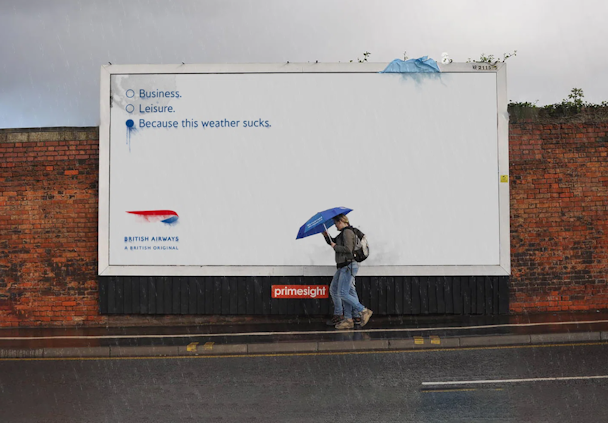Is the British Airways brand robust enough to return to its glory days?
As part of The Drum’s Travel & Tourism Focus, we speak to airline strategists about the disconnect between brand BA and the BA customer experience.

Uncommon's record-breaking 2022 campaign for British Airways
For a short time in 2022, British Airways looked like it was on course to become the jewel in British aviation’s crown once again. A high-profile brand overhaul and record-breaking marketing campaign, ‘The British Original,’ from Uncommon Creative Studio saw 500 individual print, digital and outdoor executions hit the streets, supported by 32 short films.
That award-winning campaign, and others since, have all aimed at resetting the BA brand as genuinely British, genuinely original and genuinely premium. Numerous strategic and creative marketing awards and accolades have followed, all suggesting an imminent return to glory for brand BA.
Explore frequently asked questions
Unfortunately, while marketers have lauded the brand’s activity, consumers haven’t been quite so giddy and aren’t being swept along on marketing’s wave of brand admiration. Since the overhaul, passenger reviews and press reports have suggested there is little ‘original’ about the British Airways experience – it’s every bit as unenjoyable and frustrating as other ‘lesser’ airlines.
Recent stats paint a grim picture. In the last 12 months alone, BA has canceled 4,033 flights from UK airports, which is 2.3% of its total flights from the UK. That is almost double the number of cancellations of the oft-derided budget airline EasyJet and comfortably above the industry average of 1.7%. Throw in issues around baggage handling at Heathrow’s T5, a drop in the quality of in-flight catering and entertainment and clunky online booking systems and apps all strongly suggest that the BA travel experience is actually below ‘average.’ So, where does that leave the BA brand today?
Advertisement
It’s complicated
“It’s a complex one,” says House 337’s head of strategy, Georgina Murray-Burton, who has experience handling strategy for airline brands Air Jamaica and Tui. “On one hand, its rich history has built perceptions of pride, proudly representing us around the world – premium quality, ‘cut above’ travel, ’proper’ global connectivity, a taste of home and excellent safety records. But increasingly, the more salient perceptions are ones of disarray, dissatisfaction and disappointment. So, I’d say it’s a real blend of admiration and frustration.”
Murray-Burton explains that the dichotomy for its legacy versus the reality of service shortfalls represents both a challenge and opportunity for the brand, which is currently being led by chief executive Sean Doyle, who is furiously trying to regain that ‘premium’ tag.
“Its brand equity is still strong, but it’s eroding,” says Murray-Burton. “Also, other airlines are adapting and innovating to reap the rewards of disgruntled passengers. Personally, it’s a brand I’ve always wanted to get my hands on – I have a real love/hate relationship with it. I’m fiercely loyal and yet I’m continuously frustrated with it.”
Airlines are perhaps the best example of the CX maxim that you should always set and then meet expectations. This is where the BA disconnect is – its brand heritage is propping up what has become a diluted service and experience.
Airlines are being squeezed
Drawing on experience working on airline brand Delta, Matt Rebeiro, executive strategy director at Iris, explains that Ryanair gets away with “crappy service” because it sets a low bar for customer experience: “You know that going in. It is literally priced into the ticket. Similarly, many Middle Eastern airlines, such as Emirates and Etihad, set a premium expectation and then deliver on it. The danger is always if you set a premium expectation but deliver a budget experience. And a lot of airlines in the squeezed middle, including British Airways, are struggling in this regard. They have to find ways to remain cost-competitive, often at the expense of customer experience, while not outwardly looking and feeling cheap. Smart partnerships can help here; for example, BA recognizing that its food offering was poor and partnering with M&S made a lot of sense.”
The view of brand BA in the US appears slightly rosier. Austin-based agency GSD&M manages the brand marketing for Southwest Airlines and its SVP of strategy & insights, Kate Rush Sheehy, says of BA: “A brand is more than a campaign; it’s the sum of all the moments people interact with it, so if you have too many flights delayed or regularly have a bad booking or flight experience, no campaign is going to fix that.
“I can’t speak to how British consumers feel about it, but I know [the ‘British Original' campaign] had an impact on Americans who chose British Airways to fly to England. There’s something nostalgic about flying on an iconic heritage brand, like you’ve chosen a modern-day classic. That might be at odds with how consumers in the UK feel, but they fly the airline more often, which means they are inherently going to experience more frequent customer service and user experience issues.”
Murray-Burton suggests that this disconnect isn’t necessarily a recent phenomenon, stating that many recent BA campaigns haven’t matched the realities of the brand experience. “In 2012, it came out with the campaign based on the motto ‘To fly. To serve,’ but sadly, the service element was already falling off a cliff. Then, two years ago, when it should have been celebrating 100 years of the airline with fanfare, operational issues, both in and out of its control, poured cold water all over the celebrations. BA is a service brand providing a service that really matters to people. And it’s at a premium price point, so it’s arguably more important to get the customer experience right.”
Advertisement
Brand shifts can be glacial
Rebeiro says: “As with any travel brand, my experience has been that positive perception shifts are glacial, whereas negative perception shifts can happen pretty quickly when travel chaos hits. But then, often they revert to the mean over the medium term.”
As stated, BA boss Sean Doyle is furiously looking to narrow the disconnect between brand perceptions and the experience being delivered. Investment hasn’t only been directed towards the in-flight experience – digital booking systems, apps and onboard tech have also been improved. These improvements take time to be recognized, however.
“In my opinion, BA’s customer experience is premium mediocre,” says Rebeiro. “I know there are plenty of frequent fliers who bemoan the awfulness of its digital experience, but generally, when it does work, it’s all fine. It’s not remarkable, it’s not budget, it’s not luxe. It’s premium mediocre. And in fairness, this is the same for most airlines. They are expensive businesses to run and they’ve all worked out where they can nip and tuck to drive cost efficiencies and that comes through in the experience.”
Suggested newsletters for you
BA CX is a gamble
For Murray-Burton, “inconsistent” remains a keyword when it comes to the overall BA experience. “This is really where we need to deploy our British sense of humor. The BA customer experience is a roll of the dice – you never know what version of BA is going to show up that day. It’s a running joke on the forums and social media that it operates both one of the worst and one of the best business class experiences, depending on the aircraft. This inconsistency is true across almost all aspects of their customer experience.
“This roulette-like nature of using BA, the gamble on the quality of experience, is what needs to be addressed in order to secure long-term customer loyalty and reverse declining equity.”
Customer sentiment research around airline travel conducted for The Drum’s Travel & Tourism focus shows, however, that, in the UK, despite these CX issues, British Airways is still rated second for overall flying experience, behind Emirates. BA ranks as being considered more ‘reliable’ than Emirates or any other airline, in fact, which again suggests a disconnect between what the airline and marketing sectors feel about brand BA in comparison with consumers and frequent fliers. It appears there is still a lot of love for BA in its homeland.
Notable/noticeable improvements in customer experience seldom happen overnight and, in BA’s case, they’re certainly not going to improve during the course of a long-haul flight. What BA appears to still have in its corner, however, are the hopes of a nation. By and large, consumer sentiment suggests that Britain wants BA to succeed as a premium brand capable of delivering a premium service and experience.
“The BA brand is still robust enough to return to its glory days,” says House 337’s Murray-Burton. “Brand perceptions are slow to shift, so they’re currently riding on the fumes of its heyday, but if it’s going to shift back, it really needs to reboot the customer experience as soon as possible and address the things that matter to customers to maintain – and even reverse its declining brand equity. So, persist with the confident creative advertising, but parallel genuine improvements in the issues plaguing customers to prevent and reverse and further erosion of trust and perceptions of value.”
Exactly how this happens is another (much longer) article altogether.
